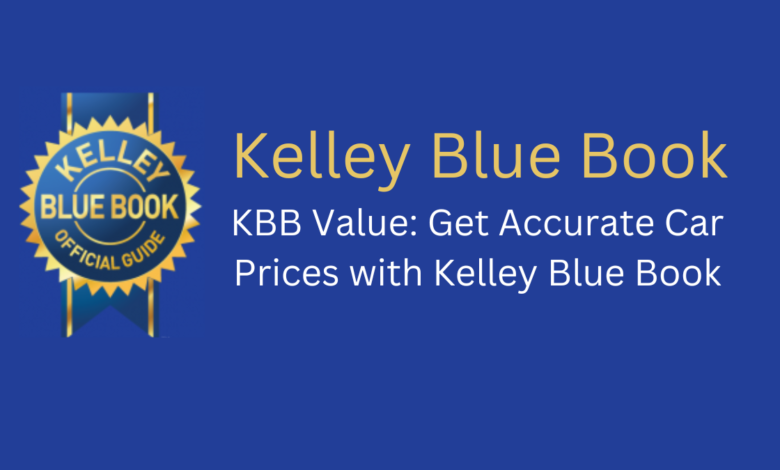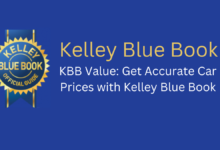
Introduction to KBB Value
Understanding the KBB value is essential for anyone buying or selling a vehicle. Kelley Blue Book (KBB) has long been a trusted resource for car valuations, providing estimates based on extensive market research. This guide will explore KBB value, how it works, and why it matters in today’s automotive landscape.
KBB value offers a reliable benchmark for car pricing, serving as a reference point for buyers and sellers. Providing insight into vehicle worth helps individuals make informed decisions during the purchasing or selling process. The KBB value reflects market trends, vehicle conditions, and regional factors, ensuring users access accurate information.
Whether you’re looking to trade in your vehicle, buy a used car, or want to know how much your car is worth, understanding KBB value can significantly enhance your knowledge and confidence in any automotive transaction. Let’s dive deeper into KBB and how it determines vehicle values.
Understanding Kelley Blue Book (KBB)
Kelley Blue Book, commonly known as KBB, is a trusted vehicle pricing and information source. Founded in 1926, it has built a reputation for providing accurate and comprehensive data about new and used cars. Over the years, KBB has evolved from a printed guide to a robust online platform, making it easier for consumers to access vehicle values.
The methodology behind KBB involves analyzing vast amounts of data collected from various sources, including dealerships, auctions, and private sales. This data is then used to create valuation models that consider vehicle make, model, year, mileage, and overall condition. KBB’s commitment to accuracy and transparency has made it a go-to resource for millions of consumers.
Moreover, KBB offers a user-friendly interface that allows individuals to search for vehicle values by entering their car’s details. This convenience, coupled with the reliability of its data, positions KBB as a critical player in the automotive industry. Understanding how KBB calculates car values is essential for utilizing this tool effectively.
Types of KBB Values
Kelley Blue Book provides several values that cater to different scenarios in the automotive market. Each type serves a specific purpose, ensuring buyers and sellers can accurately assess their vehicles’ worth.
Trade-in value represents the amount a dealership will offer when you trade in your vehicle. This value is generally lower than retail since dealers must resell the car profitably. Understanding trade-in value helps sellers gauge what they can expect from a dealership.
On the other hand, private party value is the estimated amount a seller can expect to receive when selling directly to another individual. This value tends to be higher than the trade-in value, as it reflects the car’s worth in a private sale context. Knowing trade-in and private party values can aid in making strategic selling decisions.
Certified Pre-Owned (CPO) value is also crucial for those considering a CPO vehicle. This value reflects the price of cars that have undergone thorough inspections and meet specific manufacturer criteria. Retail value, the price at which a dealership lists a vehicle for sale, is typically the highest of all values. It accounts for dealer overhead and market demand, making understanding the higher end of vehicle pricing essential.
How to Find Your KBB Value
Finding your KBB value is straightforward, thanks to Kelley Blue Book’s user-friendly online platform. Users can access the site and navigate through the value estimation process easily. To find your KBB value, enter your vehicle’s details, including make, model, year, and condition.
One of the most accurate ways to determine your vehicle’s worth is using the VIN (Vehicle Identification Number). Entering your VIN into the KBB search tool lets you retrieve precise information about your car’s specifications and corresponding value. This method reduces the margin of error, providing you with a tailored valuation based on your vehicle’s history.
Additionally, KBB offers a value calculator that helps users estimate their car’s worth based on various factors. This interactive tool considers the vehicle’s condition, mileage, and location to generate a more accurate estimate. Utilizing these resources empowers users to make informed decisions when buying or selling a car.
KBB Value for Different Vehicle Types
Kelley Blue Book recognizes that different vehicle types require unique valuation considerations. Cars, motorcycles, RVs, and trucks all have distinct factors that affect their KBB values.
Various elements come into play when determining KBB value for cars. These include the vehicle’s make and model, engine size, fuel efficiency, and additional features. KBB uses data from sales transactions to assess how these factors impact the vehicle’s market value, ensuring accurate pricing.
Motorcycles are another category in which KBB provides specialized values. Factors such as engine displacement, brand reputation, and model popularity significantly influence motorcycle values. Understanding these nuances helps buyers and sellers navigate the motorcycle market effectively.
Recreational vehicles (RVs) and campers also present unique valuation challenges. When determining RV values, KBB considers factors like the vehicle’s size, amenities, and overall condition. Similarly, trucks have specific criteria that impact their worth, including payload capacity and towing capability. By addressing these differences, KBB ensures users receive accurate valuations for all vehicle types.
Factors That Affect KBB Value
Several key factors influence a vehicle’s KBB value, and understanding these can help buyers and sellers alike. Vehicle condition is the most significant determinant. A well-maintained car with minimal wear and tear will fetch a higher price than one that shows signs of neglect or damage.
Mileage is another critical factor that KBB considers. Lower mileage typically correlates with less wear on the vehicle, which often leads to a higher KBB value. On the contrary, high mileage can significantly reduce a vehicle’s worth, especially in markets where reliability is paramount.
Market trends also play a role in KBB valuation. Economic factors, fuel prices, and consumer demand can all affect how much buyers are willing to pay for a vehicle. Seasonal changes can also influence values, with certain cars becoming more desirable at different times of the year. For instance, convertibles may see a spike in value during summer, while trucks may be in higher demand during winter.
Location is another factor that can impact KBB value. Regional preferences, climate, and local economic conditions contribute to how much buyers are willing to pay. Understanding these variables allows sellers to price their vehicles competitively.
The Importance of KBB Value in Buying and Selling
KBB value is an essential tool for buyers and sellers in the automotive market. Understanding KBB values enables sellers to set realistic prices that reflect their vehicle’s worth. This knowledge can lead to quicker sales and maximize the chances of winning on potential offers.
On the other hand, buyers benefit from KBB values by gaining insights into what they should expect to pay for a vehicle. With access to KBB values, buyers can negotiate better deals and avoid overpaying for a car. This transparency is crucial in fostering a fair marketplace.
KBB value also plays a significant role in trade-in deals. Dealerships often use KBB values as a reference point when making offers on trade-in vehicles. Understanding these values empowers sellers to negotiate better trade-in deals and maximize their returns.
Limitations and Criticisms of KBB Value
While Kelley Blue Book is a trusted source for vehicle pricing, it’s essential to recognize its limitations. One common criticism is that KBB values may not always reflect real-time market conditions. Fluctuations in supply and demand can lead to discrepancies between KBB values and actual sale prices.
Moreover, KBB values primarily rely on historical data, which may not account for recent consumer preferences or market dynamics changes. In some cases, the KBB value might only partially capture the uniqueness of certain vehicles, especially rare or limited-edition models.
Other resources, such as NADA (National Automobile Dealers Association) and Edmunds, provide additional insights into vehicle valuations for those seeking alternatives. Comparing KBB values with these platforms can offer a more comprehensive understanding of a vehicle’s worth.
How to Maximize Your KBB Value
If you want to sell your vehicle, several strategies exist to maximize your KBB value. Firstly, maintaining your car in excellent condition is crucial. Regular servicing, cleaning, and addressing minor repairs can significantly enhance your vehicle’s appeal to potential buyers.
Timing your sale is also important. Certain seasons may yield better prices for specific vehicle types. For instance, selling a convertible in spring or summer can lead to higher offers. Conversely, selling an SUV during the fall can attract buyers preparing for winter.
READ TO:The Art of Enjoying Don Julio Tequila
Understanding the depreciation curve is another crucial aspect of maximizing your KBB value. Vehicles lose value over time, but specific models depreciate more slowly than others. Researching which cars are valued well can inform your purchasing decisions and improve resale outcomes.
Conclusion
In summary, KBB value is a crucial resource for anyone in the automotive market. Whether buying, selling, or trading in a vehicle, understanding KBB values can empower you to make informed decisions. Kelley Blue Book plays a vital role in facilitating fair transactions by providing transparency and insights into vehicle worth.
To maximize your experience with KBB, stay informed about the various factors that influence vehicle values and consider both KBB and alternative resources for a well-rounded perspective. Armed with this knowledge, you can confidently navigate the car buying and selling process.

